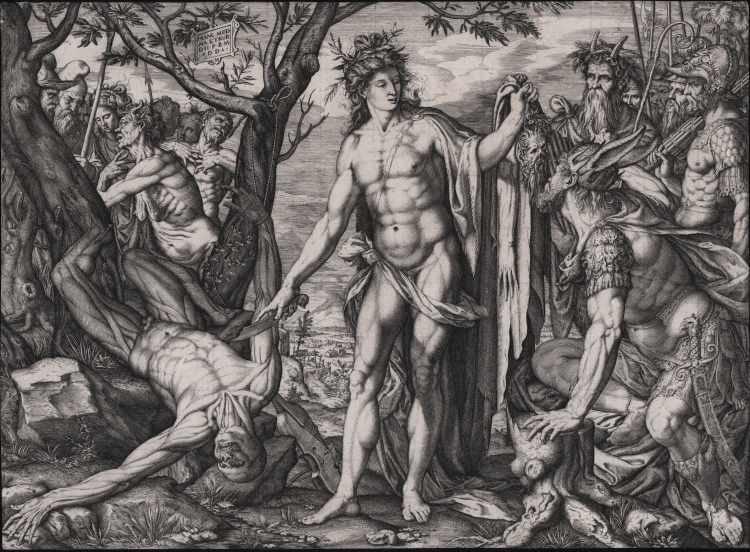




| Reference: | S39059 |
| Author | Melchior MEIER |
| Year: | 1581 |
| Measures: | 312 x 227 mm |



| Reference: | S39059 |
| Author | Melchior MEIER |
| Year: | 1581 |
| Measures: | 312 x 227 mm |
Engraving, 1581, signed and dated on plaque: FRANC.[ISCO] MED[ICEO]/MA. [GNO] ETRVR. [IAE] D.[UCI] II. P.[ATRONO] B.[ENE] M.[ERENTI]/ 15. D[e]D[ICAVIT] 81./ M. M.
A great example, printed on contemporary laid paper, with “eagle in circle, crowned” watermark, trimmed close to platemark, in good condition.
This stunning scene draws on two entertaining episodes from Ovid’s Metamorphoses. The section on the left draws on Ovid’s account of the punishment inflicted on the satyr Marsyas for his boast that his musical talents surpassed those of the god Apollo. Elsewhere, Ovid relates a musical contest between the Arcadian god Pan and Apollo, in which Apollo transforms Midas’s ears into those of a donkey for preferring Pan’s tunes. Meier’s representation skilfully weaves together these twomythological tales, depicting the flayed Marsyas on the left, while the god mocks the donkey-eared Midas with Marsyas’ flayed skin on the right.
The engraving is dedicated to Francesco I de Medici. It has been proposed that Melchior intended a compliment to Duke Francesco as the Apollo of the Florentine art scene. However, subjects as Apollo flaying Marsyas and the martyrdom of St. Sebastian became increasingly popular after the appearance of Vesalius’ book of 1543 since they afforded artists the opportunity of combining a display of their anatomical knowledge with a standard artistic subject.
The depiction of mighty Apollo in the centre of the engraving shows the unmistakable influence of the Apollo Belvedere, one of the most famous of the classical sculptures that were studied by Renaissance artists, although, perhaps due to his northern sensibility, Melchior really missed the niceties of the statue’s stance and the modestly draped the figure as well. In accordance with late sixteenth - century taste, the figure is more evidently muscular than the original.
Marsyas was linked iconographically to the apostle St. Bartholomew, immortalized in Michelangelo's Sistine Chapel Last Judgment. Perhaps more relevant, however, flaying became topical again in 1571, when the Venetian commander Marcantonio Bragadin, defender of Cyprus, was flayed alive by invading Turks. In 1580 Bragadins skin was stolen from Constantinople and returned to Venice. With disparate figural groups, Meier's 1581 print alludes to the ongoing conflict.
|
Bartsch, XVI.246; Barryte, pp. 332 -333 n. 27; The Simple Art, n. 31, pp. 56-57; Nagler, IV, p. 562, no.1802; Hollstein 7.
|
Melchior MEIER(attivo in Svizzera tra il XVI ed il XVII secolo)
|
Bartsch, XVI.246; Barryte, pp. 332 -333 n. 27; The Simple Art, n. 31, pp. 56-57; Nagler, IV, p. 562, no.1802; Hollstein 7.
|
Melchior MEIER(attivo in Svizzera tra il XVI ed il XVII secolo)